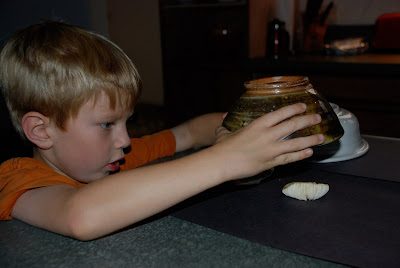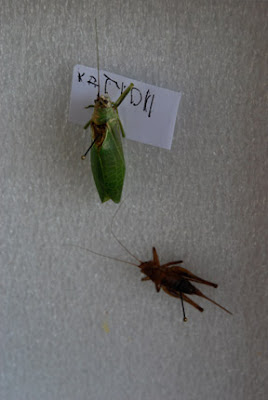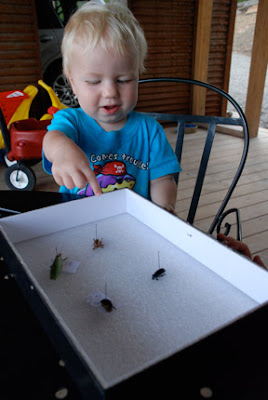Tuesday, September 7, 2010
Making Mushroom Prints

Mushrooms are arguably one of nature's most curious and fascinating life forms. Even my one-year-old takes notice, pointing them out as we walk through the woods. Existing in many different forms, some are bright and colorful, others are strange and stinky. Add to that the fact they can appear almost overnight, one can begin to appreciate these unworldly organisms.
- Construction paper (dark colors work the best)
- Scissors
- Bowls
- Hairspray or spray fixative (optional)
- Head outside (ideally a few hours after a rain shower).
- Collect mushrooms - try and find a "traditional" cap mushroom with gills underneath.
- Cut the mushroom stem at the base.
- Carefully place the mushroom, gill side down on a piece of construction paper.
- Cover the mushroom with a bowl and let it sit overnight.
- Remove the bowl and lift up the cap.
- Marvel at the beauty of your spore art!
- Let the paper dry, then seal it with hairspray or spray fixative. Spray far above the print so spores are not blown off the paper.



Wednesday, August 18, 2010
Mushroom Gallery
Thursday, August 12, 2010
Perseids Meteor Shower TONIGHT!
Get ready for a dazzling show of natural fireworks. Tonight marks the peak of the Perseids meteor shower, and scientists are gearing up for what is expected to be the most magnificent show of the year, peaking at possibly 50 or more meteors per hour! Tonight is an especially good night for viewing due to the waxing cresent moon setting early in the evening, leaving a dark sky for the show.
During meteor showers, like the one happening this evening, the meteors appear to originate from a single point in the sky called the radiant. This occurs because the showers are associated with disintegrated comets or comets still orbiting the Sun, leaving behind clumps of gravel and dust that spreads out along the original orbit of the comet. When one of these streams of particles enters the Earth’s atmosphere, the meteors appear to originate from a single point.
Tonight’s meteor shower is called Perseids, so named because meteors will radiate from a point in the constellation Perseus, the Hero. The Perseid meteor shower happens every August when Earth passes through a stream of particles left behind from Comet Swift-Tuttle. If you have no idea where Perseus is in the night sky, don’t worry! The meteors will appear in all parts of the sky.
Meteor Shower Viewing Tips
The best time for viewing is between midnight and dawn tonight (the morning of August 13th)
Find a dark sky (if it’s not dark where you are, come on out to our place!)
Set up your camping chair or blanket and enjoy the spectacular show with family and friends!
Tuesday, August 10, 2010
Wednesday, August 4, 2010
Max's Insect Collection










Sunday, August 1, 2010
Friday, July 30, 2010
Mud Daubers: Friend or Foe?
 I've been spending a lot of time in my garage lately. Unfortunately, at the moment it is not serving its intended purpose. Instead of housing our vehicles, the garage has become a dumping ground for unclaimed moving boxes, sculptures and extra large art projects made by my little ones, and other miscellaneous items that just somehow find their way there when I'm not looking. Now for those of you that don't know, this garage is something of a miracle. Days before we were to finalize our house plans, I decided that I could not live without one. My builder/husband informed me that this type of last minute decision (which he described as a "disease" that people have in building) would cost us money that was not in the budget. I was unfazed. I wanted a garage.
I've been spending a lot of time in my garage lately. Unfortunately, at the moment it is not serving its intended purpose. Instead of housing our vehicles, the garage has become a dumping ground for unclaimed moving boxes, sculptures and extra large art projects made by my little ones, and other miscellaneous items that just somehow find their way there when I'm not looking. Now for those of you that don't know, this garage is something of a miracle. Days before we were to finalize our house plans, I decided that I could not live without one. My builder/husband informed me that this type of last minute decision (which he described as a "disease" that people have in building) would cost us money that was not in the budget. I was unfazed. I wanted a garage. Wednesday, July 28, 2010
It starts with an "S" and ends with a "T" ...

Scat Rap
(1988 Andy Bennet, Mary Keebler, Rodd Pemble, Doug Elliott, Billy Jonas)
Hunting crawdads, it was Mr. Raccoon.
You park your car by a wood or field,
Gonna find scat on your window shield.
Full of seeds, purple and white
You just got bombed by a bird in flight.
If you wanna know what’s in the woods or around,
Take a good long look at the scat on the ground.
It tells us what they eat and tells us who they are,
And that’s what we know about scat so far.
A Whippoorwill Welcome!
Just hours after settling in to our new abode (a nearly two year labor of love by my over-worked and entirely spent husband), we received a warm welcome from the neighbors. Fully aware that this was no ordinary neighborhood, considering the mile and a half drive on a dirt road perfectly designed for a high-clearance 4-WD vehicle, and also the fact that there is not a house in sight, I was not expecting any casseroles or bottles of wine. No, this welcome gift was much more fitting - the call of the whippoorwill! Actually, whippoorwills. In fact, we could not determine how many were out there, they were making such a ruckus!
Due to their nocturnal habits, these birds are often heard but not seen. We could certainly hear them loud and clear, but I had to resist the urge to tromp in the woods to try and get a closer look, knowing that my chances of actually seeing one was pretty slim. Their cryptic coloration allows them to blend perfectly with the forest floor on which they nest. Careful not to give away their location and any chicks they may be protecting, a whippoorwill will wait until the last possible moment before flushing their nest.
While relishing our private whippoorwill chorus, my husband, Zach was convinced the unrelenting song of this woodland bird was along the lines of “WHIP-poor-WEET.” I, however, being the more experienced birder, heard the distinctive and familiar “WHIP-poor-WILL," laughing off this poor man's ridiculous declaration. After doing some research, however, I discovered that perhaps he was not delirious from exhaustion. The Cornell Laboratory of Ornithology describes the eastern species call as “WHIP-poor-WEEA, not "WHIP-poor-WILL.” Of course, I kept this piece of information to myself, insignificant as it is.
Whatever they're saying, whippoorwills are welcome neighbors here on Brown-Trout Acres, feasting on insects (of which we have no shortage) and singing well into the night.
There were a lot of uncertainties about moving into the wilderness, but I never imagined rowdy neighbors being one of them. Goodbye suburbia, hello wild Appalachia!

Let the wild whippoorwill rumpus begin!


















